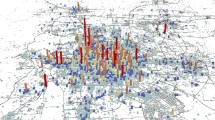Abstract
This research examines the spatio-temporal distribution of population in an urban environment and its relationship with urban functions using an unprecedented high-resolution and broad-coverage-crowd LBS dataset from Tencent, one of the biggest Internet companies in China. By examining the distribution of the population during different time periods, different urban morphologies are observed. The analysis of the spatio-temporal population distribution based on temporal entropy indicates that population distributions of employment, commercial, and scenic areas have larger temporal fluctuations than those in residential and mixed-use areas. As for the Spearman correlation coefficient between urban functions and temporal population distribution based on 300 × 300-m grids, it is then measured to uncover the underlying reason for this spatio-temporal distribution of population. The result demonstrates that as urban functions become more mixed, the temporal distribution of the population becomes more even. At a local scale, temporal population distribution in key areas shows that the location of people in a certain place is in accordance with human behavior. The population in employment-dominated areas shows large fluctuations on weekdays but is relatively evenly distributed on weekends. The population in commercial areas only peaks for several hours on both weekdays and weekends. Comparatively, mixed areas and large-scale residential communities accommodate a stable number of people at all times.








Similar content being viewed by others
References
Bo, W., Feng, Z., & Hao, Z. (2015). The dynamic changes of urban space-time activity and activity zoning based on check-in data in Sina web. Scientia Geographica Sinica, 35(2), 151–160.
Deville, P., Linard, C., Martin, S., et al. (2014). Dynamic population mapping using mobile phone data. Proceedings of the National Academy of Sciences, 111(45), 15888–15893.
Frank, L. D., & Pivo, G. (1994). Impacts of mixed use and density utilization of three modes of travel: Single-occupant vehicle, transit, and walking. Transportation Research Record, 1466, 44–52.
Kang, C., Liu, Y., Ma, X., et al. (2012). Towards estimating urban population distributions from mobile call data. Journal of Urban Technology, 19(4), 3–21.
Kitchin, R. (2014). The real-time city? Big data and smart urbanism. GeoJournal, 79(1), 1–14.
Li, M., Shen, Z, & Tao, Y. (2015). Application of spatial and temporal entropy based on multivariate data for measuring the degree of urban function mix. China City Planning Review, 24(1), 40–48.
Liu, L., Hou, A., Biderman, A., et al. (2009). Understanding individual and collective mobility patterns from smart card records: A case study in Shenzhen. In 12th international IEEE conference on intelligent transportation systems, 2009. ITSC’09. IEEE 2009 (pp. 1–6).
Liu, Y., Wang, F., Xiao, Y., et al. (2014). Urban land uses and traffic ‘source-sink areas’: Evidence from GPS-enabled taxi data in Shanghai. Landscape Urban Plan, 106(1), 73–87.
Long, Y., & Thill, J. (2015). Combining smart card data and household travel survey to analyze jobs–housing relationships in Beijing. Computers, Environment and Urban Systems, 53, 19–35.
Long, Y., Zhang, Y., & Cui, C. Y. (2012). Identifying commuting pattern of Beijing using bus smart card data. Acta Geographica Sinica, 67(10), 1339–1352.
Louail, T., Lenormand, M., Ros, O. G. C., et al. (2014). From mobile phone data to the spatial structure of cities. SCI REP-UK, 4.
Ning, X., Ling, Y., & Jinxing, H. (2014). Identifying home-work locations from short-term, largescale, and rgularly sampled mobile phone tracking data. Geomatics and Information Science of Wuhan Univers, 39(6), 750–756.
Pei, T., Sobolevsky, S., Ratti, C., et al. (2014). A new insight into land use classification based on aggregated mobile phone data. International Journal of Geographical Information Science, 28(9), 1988–2007.
Reades, J., Calabrese, F., & Ratti, C. (2009). Eigenplaces: Analysing cities using the space-time structure of the mobile phone network. Environment and Planning B: Planning and Design, 36(5), 824–836.
Steenbruggen, J., Borzacchiello, M. T., Nijkamp, P., et al. (2013). Mobile phone data from GSM networks for traffic parameter and urban spatial pattern assessment: A review of applications and opportunities. GeoJournal, 78(2), 223–243.
Suhong, Z. (2015). Study on dynamic structure of cities based on questionnaire and floating cars’ GPS data. In Symposium on big data and spatio-temporal behavior planning, Tongji University, Shanghai 2015-01-04 (in Chinese).
Wang, M., Zhou, J., Long, Y., & Chen, F. (2016). Outside the ivory tower: Visualizing university students’ top transit-trip destinations and popular corridors. Regional Studies, Regional Science, 3(1), 202–206.
Xia, M., Rongrong, X., Xinshuo, L., et al. (2010). Fine grid dynamic features of population distribution in shenzhen. Acta Geographica Sinica, 65(4), 443–453.
Xinyi, N., Liang, D., & Xiaodong, S. (2014). Understanding urban spatial structure of shanghai central city based on mobile phone data. Urban Planning Forum, (6), 61–67.
Yuan, J., Zheng, Y., Xie, X. (2012). Discovering regions of different functions in a city using human mobility and POIs. In Proceedings of Acm Sigkdd conference on knowledge discovery and data mining (pp. 186–194).
Yuan, N. J., Zheng, Y., Xie, X., et al. (2015). Discovering urban functional zones using latent activity trajectories. IEEE Transactions on Knowledge and Data Engineering (TKDE), 3(27), 1041–4347.
Author information
Authors and Affiliations
Corresponding author
Rights and permissions
About this article
Cite this article
Li, M., Shen, Z. & Hao, X. Revealing the relationship between spatio-temporal distribution of population and urban function with social media data. GeoJournal 81, 919–935 (2016). https://doi.org/10.1007/s10708-016-9738-7
Published:
Issue Date:
DOI: https://doi.org/10.1007/s10708-016-9738-7




